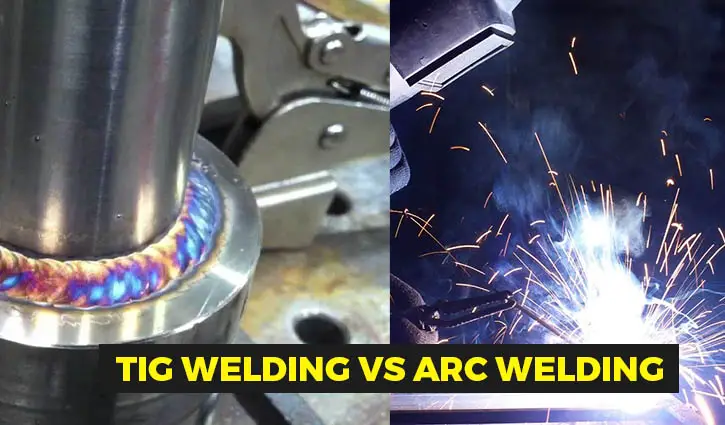For a variety of purposes and skill levels, there are numerous welding techniques. Two of the most common are tig welding and arc welding. Examining your prior welding expertise and the types of materials you plan to weld will help you decide which welding technique is best for you.
Tig welding means here a non-consumable electrode welding process that is primarily used in the sheet material industry to make aesthetically pleasing work. Arc Welding requires electrodes and it’s used in the manufacturing and construction industry.

Continue reading to find out more about Tig Vs Arc Welding and to decide which one best suits your requirements.
Comparison Table on Tig and Arc Welding
We have pointed out a few factors for you to choose between Tig Welding vs Arc Welding. Take a look!
| Topic | Tig Welding | Arc Welding |
| Abbreviation | Tungsten Inert Gas Welding | Manual Metal arc Welding or Stick Welding |
| Electrode status | Non-consumable | Consumable |
| Working process | Complicated | Comparatively easier |
| Works best | Thin sheets | Thick material |
| Gas | Require | Doesn’t require |
| Most seen | Artwork | Construction |
| Strength | 100% | 75% to 80% |
| Cost | Expensive | Affordable |
| Usage | Pipeline industry, sheet metal, and aviation industry | The manufacturing industry, aerospace industry, construction industry |
Read More: Is TIG Welding Bad For Your Health?
Tig Welding
TIG welding seems an arc welding technique that creates welds using a non-consumable tungsten electrode. With control over the amperage and gas flow, it is a precise method of welding.
TIG welding can be used to join both ferrous and non-ferrous metals together. It works best on materials that are more sensitive.
Pros and Cons
Read More: What You Should Know About Argon Tig Welding?
Arc Welding
A disposable electrode wrapped in flux is used to lay the weld in the manual arc welding process. It works well with thicker materials and provides strong welds. The welding process is adaptable, the equipment is straightforward to set up, and learning it is comparatively simple.
Pros and Cons
The Similarity Between Tig and Arc Welding
- Both of them are electric arc welding processes.
- They require the inert gas.
- Most welders use argon or helium. They use it to prevent oxidation.
- These two gases are used around the welding joint.
Tig Welding Vs Arc Welding: Differences
Now, let’s come to the difference between Tig and arc welding. A tungsten electrode generally is used in TIG welding in order to create the electric arc between the metal workpiece and the flame.
The tungsten electrode, in general, is not consumed during welding that’s because tungsten comes with a high melting point. And it is more than 6,000° F. As a result, TIG welding typically results in a stable electric arc, a clean, precise, and strong weld, as well as is highly controlled.
On the contrary, the electrode is disposable in the arc or stick welding. The electrode, in contrast to TIG welding, serves as the filler metal rod and melts to become a component of the weld joint itself.
The electrode or rod also has a flux inside of it that creates a barrier to guard against ambient pollution. Additionally, the flux in stick welding electrodes often already contains the inert gas, thus no additional gas source is required.
Arc welding’s drawbacks include the potential for spatter and, generally speaking, a rougher weld than TIG.
Which one is the best comparing Tig vs Arc Welding
If you are wondering which is better between Tig and arc welding, the answer is it depends on your usage.
Both ferrous and non-ferrous metals can be welded with TIG welds, however, they work best on more sensitive materials. With thicker materials, arc welding produces welds that are durable.
If you come to compare Tig Vs Arc Welding strength, you will observe that arc welding results in 75% to 80% welding whereas tig welding results in 100% welding.
Though Tig welding is a bit expensive, it is used in aviation, sheet metal, and aerospace industries. Whereas Arc Welding is used in industrial piping, the manufacturing industry, and the construction industry.
FAQs
It is frequently considered the strongest because it produces intense heat and ductility. However, this process may seem a bit complicated and still mostly gives the best results.
Because their material lacks the holes necessary for bolted joints, welded joints are typically stronger than bolted ones. When it comes to joint strength, the manufacturing process is what matters: Although welded connectors are stronger, bolted joints are more straightforward.
Metals are joined together by an electrical current in arc welding. Metal inert gas (MIG) welding and tungsten inert gas (TIG) welding are two examples of arc welding types.
Verdict
Arguments between TIG and Arc welding are common among welders. Although both have advantages and disadvantages, neither can be regarded as indisputably “better” than the other.
When doing a certain welding project, several elements should always be taken into account, including the type of material, quantity, price, equipment, post-processing requirements, etc.
Both welding techniques are well-liked and frequently used right now.
Read More: Welding Tips And Tricks (MIG, TIG, Stick, Flux Core) Must Know